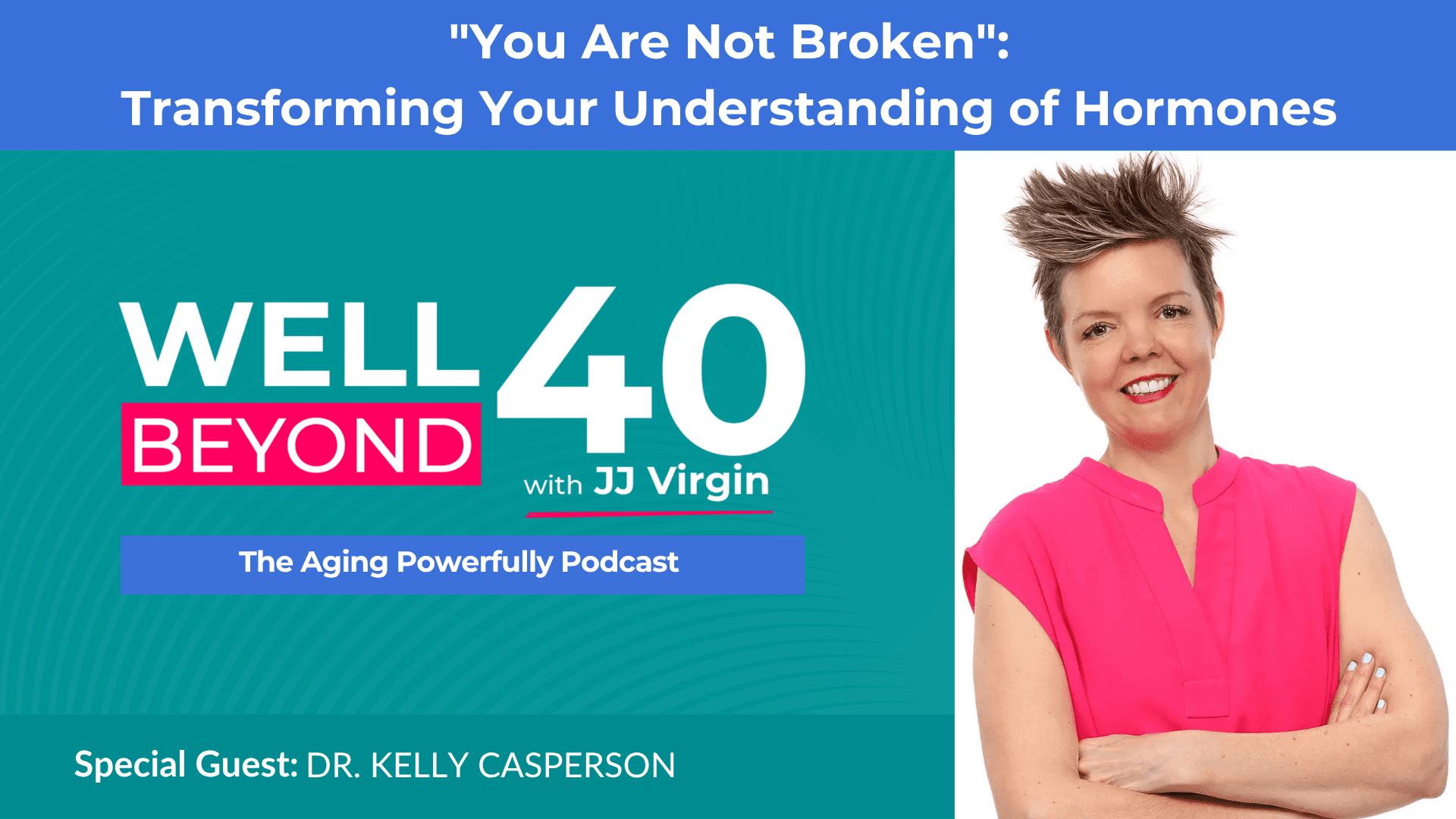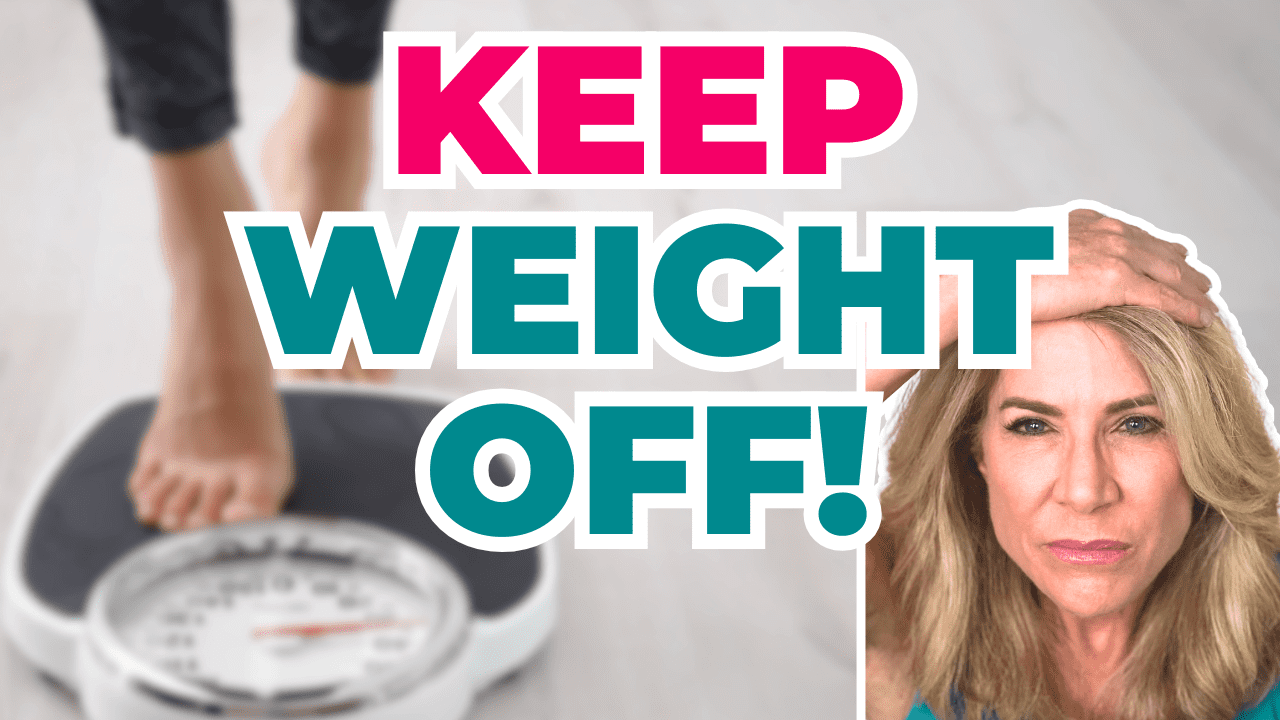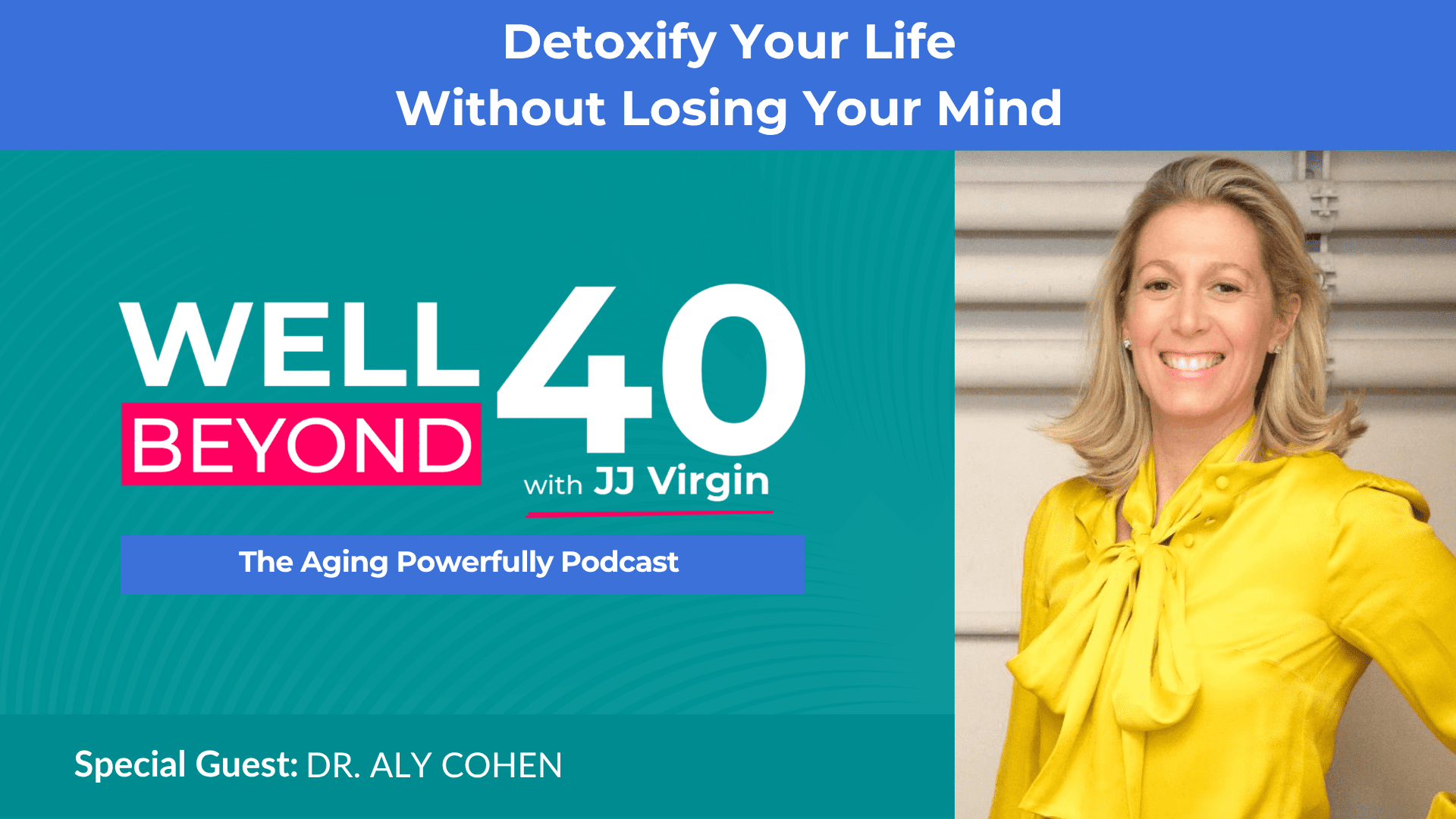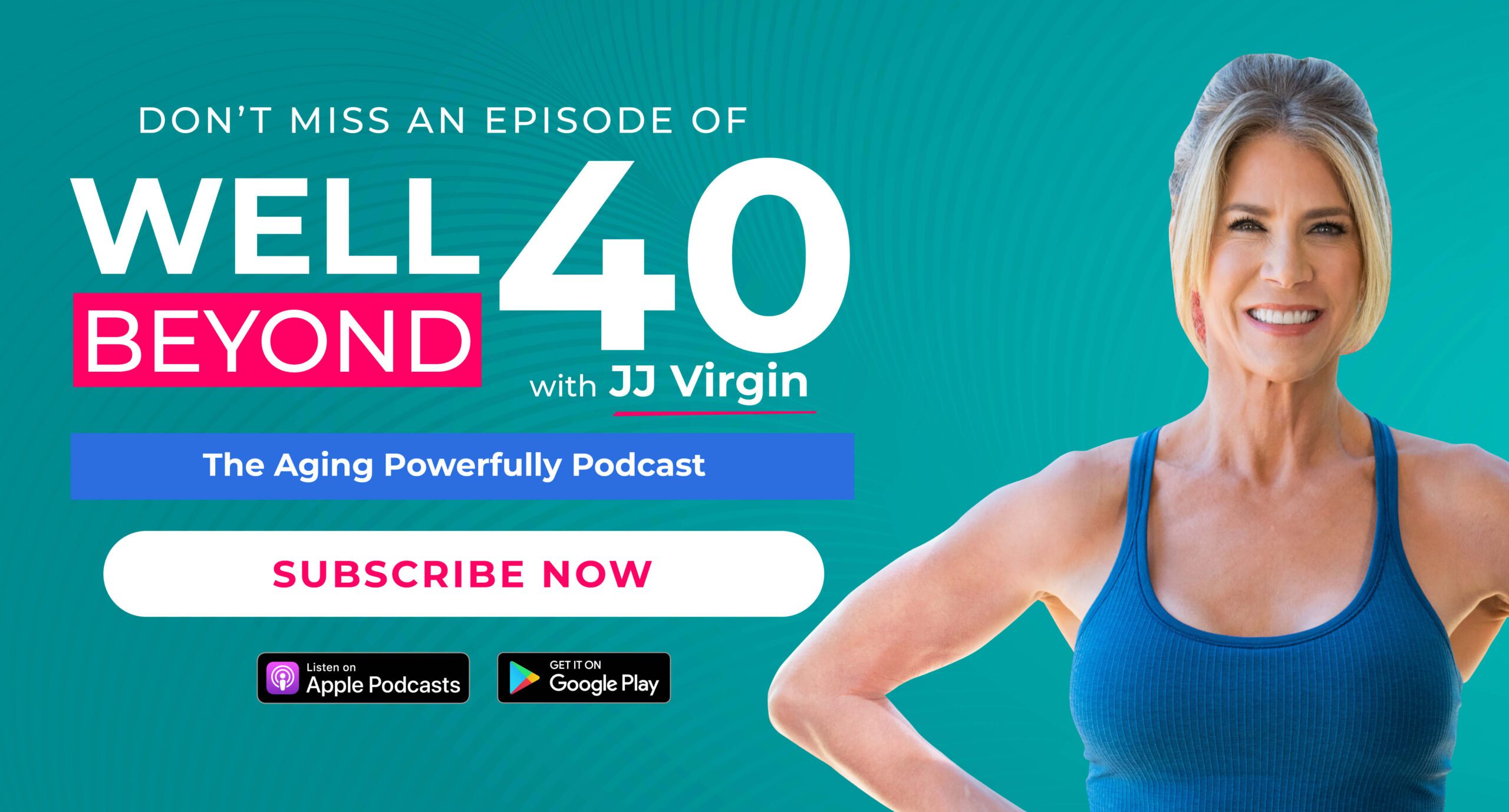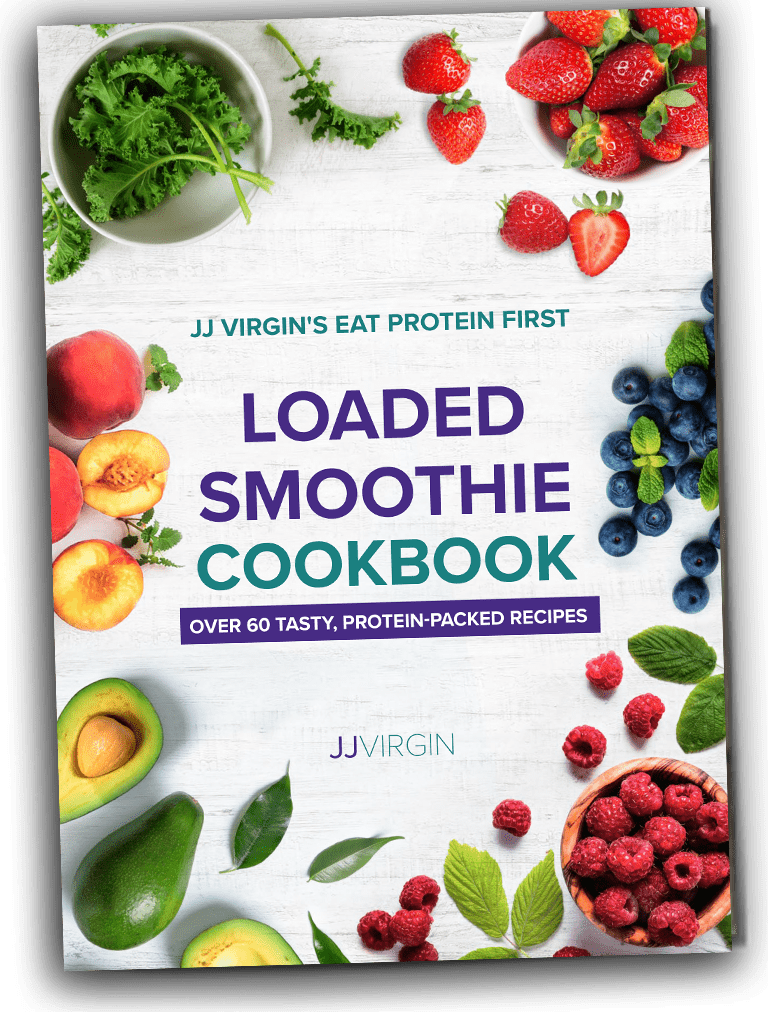Transform Your Body’s Blueprint for Aging
The statistics about aging can be frightening – from plummeting bone density to cognitive decline and muscle loss. But I’m here to tell you there’s a revolutionary approach to aging that turns these scary numbers on their head. Today, I share how a positive mindset alone can add 7.5 years to your life, and why resistance training is non-negotiable for women over 40. We dive deep into why those little pink dumbbells aren’t really serving you, and how incorporating power moves like jumping can actually reverse bone loss. I break down the science behind why high-intensity interval training becomes more crucial as we age, and reveal the game-changing benefits of creatine HCL for both brain and body health.
What you’ll learn:
- Why your mindset about aging could add years to your life
- The shocking truth about how much protein women really need as they age
- How to build power and strength without living in the gym
- The three-pronged approach to aging powerfully that starts with proper recovery
- Why traditional “aging gracefully” advice is holding you back from your best years
Love the Podcast? Here’s what to do:
Make My Day & Share Your Thoughts!
- Subscribe to the podcast & leave me a review
- Text a screenshot to 813-565-2627
- Expect a personal reply because your voice is so important to me.
Join 50,000+ followers who make this podcast thrive.
Want to listen to the show completely ad-free?
- Go to subscribetojj.com
- Enjoy the VIP experience for just $4.99/month or $49.99/year (save 17%!)
- Click “TRY FREE” and start your ad-free journey today!
Resources Mentioned in this episode
7-Day Eat Protein First Challenge
Vital Choice wild-caught seafood
Reignite Wellness™ Magnesium Body Calm
Check out my favorite Qualia products
Download my free Resistance Training Cheat Sheet
Sunlighten Sauna: use promo code JJVIRGIN when requesting pricing information for $600 off
Download my FREE Best Rest Sleep Cheat Sheet
Episode Sponsors:
Try Timeline. Use code JJ10 for 10% off all products
Try Qualia risk free for up to 100 days and code VIRGINWELLNESS for an additional 15% off
Air Doctor: get up to $300 off at AirDoctorPro.com with promo code VIRGIN, plus a 30-day money-back guarantee and FREE 3-year warranty (worth $89)
Aqua Tru: Get 20% OFF with promo code VIRGIN at AquaTru.com
This is the best kept secret to aging powerfully. So, 50 percent of postmenopausal women will experience an osteoporotic related fracture. Here’s the reality. Once you go through menopause, your bone mineral density can fall off a cliff. You can lose a thumb. third of your bone mineral density at that time.
And why that’s so risky is if you are one of those unfortunate people who does have an osteoporotic related fracture, let’s say that you have a hip fracture, your risk of dying within that year of that hip fracture is 26%. It’s actually greater than 26%. So this is really a matter of life and death. And it’s not just bones.
It’s your bones. It’s your heart. It’s your brain. In fact, what we know is that women 60 plus also have cognitive decline. Nearly a quarter of women 60 plus have cognitive decline and that subjective cognitive decline, that’s a risk factor for Alzheimer’s, for full blown dementia, and then what else happens as we age?
Mood disorders. In fact, depression amongst women. postmenopausal women, 20 percent of women postmenopausally are depressed. So you hear all of these horrific statistics and by the way, I didn’t even get into what happens with your muscle mass. Starting at around age 30, we can lose up to 1 percent of our muscle mass a year.
It’s about 3 to 8 percent per decade and it’s two times that of strength. So we lose much more strength and even more. Power. That’s how quickly we can move, how agile we can be. And I say to all of these horrific stats, not on my watch, there actually is a new way to age and that is aging powerfully. So you wanna age powerfully.
And where does that start? It actually doesn’t start with movement, although we are gonna be talking about movement. It starts with mindset. It starts with that decision. It starts with looking at the next several decades of your life and saying. These are going to be my best decades. And to really get excited about it, it turns out that if you are thinking positively about aging, that you could live seven and a half years longer just purely because of that mindset shift.
And with that positive mindset shift, what are you letting go of? That whole idea of aging gracefully. You see these memes all over the internet of what you shouldn’t be doing, what we can’t be doing. All that goes away. I want you to step into this mindset of being powerful, of doing what you want to do, of being who you want to be, of wearing what you want to wear, of hanging out with who you want to hang out with, right?
This is really The best time of life. It’s the most powerful time of life if you choose to make it so. And once you’ve chosen to make it so, the next thing you need to do is take the action to make it so. So think about it. Think about what you want to be able to do in your 60s, in your 70s, in your 80s, in your 90s.
Because the reality is those things that you want to be able to do then, maybe it’s travel, maybe it’s playing with your grandkids, maybe it’s one of my clients told me I want to be able to dance in my stilettos, whatever the heck it is, you’ve got to be training for it now. As we age, we tend to do less and the reality is The less you do, the less you can do.
So let’s flip that script. Because we also know that the more you do, the more you can do. And where it really starts is purely with something called NEAT. Non Exercise Activity Thermogenesis. or activity. Where I like to start first with people is just to have you start to track how much you’re actually moving all throughout the day.
Recently, I had a person in one of my programs, my Powerful Aging Method program. She goes, you know, I was shocked because I go to the gym three days a week and I do some HIIT training on the other day, so she’s active every day. She goes, and yet on the days I went to the gym, I was getting in 3, 000 steps a day.
And on the days I was doing HIIT training, I was getting in about 6, 000 steps a day. This is really low. But she’s actually average. The average person in the United States is getting about 3, 000 to 4, 000 steps a day. When we know that you really want to make sure you’re getting 8, 000 as the floor, because this is where you really see a bell shaped shift in your cardiovascular risk going down.
So we’re going to set a new floor for you, that you’re going to be getting in at least 8, 000 steps a day, that you really are going to be moving more all throughout the day. What does that mean? That means, yes, you do park farther away. Like, when we go to the store now, we look for the farthest place we can park, not the closest.
You’re going to look for more opportunities to take the stairs. Where can I Walk instead of park closer. Where can I take the stairs instead of the escalator or the elevator? So you’re going to move more all throughout the day to make sure that you’ve got a new floor of 8, 000 steps a day. And ideally, more is better.
And that’s your foundation. But that’s not exercise. So, in order for something to be called exercise, to be considered exercise, you need to get hot, sweaty, or have it hurt a little bit, right? You need to do more. For me, exercise means doing more than what you’re used to so that your body adapts and gets stronger.
And one of the important things that we need to do as we age is lift heavy things. I mentioned earlier that we lose muscle as we age, and we lose strength as we age. Muscle is how much muscle mass you have, how many muscle fibers you have on your body. Strength is how much you can lift one thing, one time.
We lose up to 1 percent of our muscle mass each year, starting around age 30, starts to double around age 60. But we lose twice as much strength. And we lose three times as much power. Power is how quickly we can do something. And as estrogen goes down, we really lose the ability to contract and do really heavy things.
So, we’ve got to lift heavy things. That needs to become a new mantra for you. Lifting heavy things. And here’s the reality. When you’re starting to do resistance, Since training. What’s super cool about it is yes, you’re gonna build muscle and yes, depending on how you do it, which we’ll talk about, you’re gonna build strength and you’re gonna build power.
And you might think, oh, that’s gonna make it easier for me to do things throughout the day. And yes, it will, and it’s also gonna improve your bone mineral density, but it actually does weigh more than that while it’s building muscle. And you’re getting stronger. And you’re becoming more powerful. And you’re putting that stress on your bones so they’re getting stronger too.
Remember, bone mineral density is actually a lagging indicator that you don’t have enough muscle. Other things are happening as well. When you contract muscles, your muscles release these chemical messengers called myokines. This actually can make your brain better, your immune system better, your mood better, can reduce inflammation, can make you better at burning fat.
So a lot of those things you heard about that are risks as we age, you know, you’ve got higher risk for heart disease. It’s the number one killer of women. Your mood goes down. You have a risk for dementia. A lot of these things. Exercise is the way to counteract all of these different things, but the right type of exercise is key, and for us, resistance training is going to take center stage, but very specifically, I want you to think about Hard resistance training.
This is not going to the gym with those little one and two pound pink dumbbells and thinking you’re doing something because you’re doing some arm circles. This is doing big, compound, functional movements because we are working out to get better at life. You’re not training to get better at going to the gym.
You’re training to get better at life. And so, I want you to think of doing things that mimic what you do in life. In life, you gotta get up off the toilet, and I’m guessing you don’t want to have to call your partner for help, right? So, things like squats become super important. You have to pick up things off the floor, so a deadlift or a bent over row is important.
You have to put things overhead, so an overhead press becomes very important. So when I’m looking at designing a great exercise routine, I’m using compound movements that cross multiple joints. I’m doing functional things that also pull in my core and mimic how I go through life. So that’s the first thing is we’re going to do resistance training.
That’s hard to show us that we can do hard things to help our body get stronger and to pull in our core as well so that we don’t get injured when we’re doing something like pulling the groceries out of the car. So that’s first step, lift heavy things. Now, that’s great for building that muscle and for getting you stronger all throughout the day.
But there’s another thing that we’re going to add into the mix, and that’s something called high intensity interval training. High intensity interval training is different than steady state aerobic training, although they both work your heart. In that, let’s say that you’re used to right now going out for a walk.
And that’s great, and you’ll get those steps in, but now what I want you to do is throw in some hard intervals into that. So let’s say you’re going out for a walk. What you would do is go out for a walk, and then walk for a minute, run for a minute, walk for a minute, run for a minute. If you can’t run, you can get on a bike, walk for a minute, bike for a minute.
There’s a variety of different ways you can do this, but the big important idea here is that you’re going to do something easy, and then you’re going to do something quick. All out, whether it’s a sprint, whether it’s running upstairs, whether it’s doing air squats, something that gets you out of breath and then you’re going to recover for a minute and repeat.
The reason this is so important is it trains your central nervous system how to handle stress. It also helps your body burn off visceral adipose tissue. It also helps you become more insulin sensitive, just like resistance training does, but also starts to build up something called lactate. And lactate is a very interesting thing that happens as we do intense exercise.
We build up lactate and this is one of the ways that we can start to get our brain and our heart working. working really well because they are a fuel source for our brain and our heart that help us make new cells. So we actually create something called mitogenesis where we create new mitochondria because of this.
So we want to be doing HIIT training. And then the last thing we’re going to add in here is jumping. And this might sound crazy to you because you might be going, Oh, I’m afraid I’ll get hurt doing that. Remember, we are training to get better at life. And in life, you might have to jump out of the way. And as we age, we start to lose that explosive muscle fiber.
And so what we want to do is train those things that we are losing. In life, especially for women, we tend to have more of these oxidative, slow twitch muscle fibers. And if we work more in that range of doing things like yoga or walking, we’ll actually build more of those and start to lose more of these fast twitch fibers that can help us move fast and be powerful.
So we’ve got to train. The fast twitch, the more powerful fibers. And one of the easy ways to do that is with jumping. The other reason I love jumping is it’s stressing your bones. And if you want to reverse osteopenia or osteoporosis, a great way to do that is to start with jumping. Now, I have to do the disclaimer that if you’ve got osteoporosis, be sure to consult with your doctor first.
But this can be as simple as when you’re doing your air squats, adding in a little bit of a hop. And then once you’ve been adding in a hop, And doing, say, 10 air squat jumps, then you can jump up onto a box, right? So this can be a very easy thing to start with, but jumping is something you’re going to want to incorporate into your program a couple times a week.
So we’ve got moving more all throughout the day, getting that walking, that stepping in. We’ve got resistance training. Lifting heavy to build what I like to call the metabolic spanx. It holds everything in tighter, boosts your metabolism, but then has the myokine effect that does all of this other great stuff for your body.
And then we’re going to add in some interval style training to really help with your central nervous system, to help your body handle stress better, to get the lactate going, to help fuel your brain and your heart, and then also to help burn off that visceral adipose tissue. And then throw in some jumping, which of course can also be a form of interval training.
You try doing jumping for 30 seconds, it’s definitely interval training. One of the nutrients I love that supports this really well is creatine, HCL. Now you’ve probably heard about creatine. If you’ve heard about creatine, you’ve probably heard about creatine monohydrate because it’s been the most researched form of creatine.
However, What we’ve seen with creatine monohydrate is that it also can have some side effects that women don’t like, and so they get off of it pretty quickly. It can cause some GI distress and some bloating. Turns out that if you shift the form to something called creatine, HCL, you have 99% absorption of it compared to about 15% absorption of creatine monohydrate, which is why you have to use a high dose of creatine monohydrate three to five grams.
versus 750 milligrams to a gram of creatine HCL, but you’ll get all of the benefits of creatine without some of those side effects. What creatine does is helps your body create more energy because creatine lends itself into the creatine. phosphate system. So this is the quick energy system of the body.
So creatine is going to help you work out harder, recover better, which allows you then to build more muscle and build better bone. The other thing creatine does is we’ve got most creatine in our muscle tissue but a little bit in our brain. What’s unique about creatine HCL versus monohydrate is it actually will cross the blood brain barrier and so it can help.
with cognition. It can help with neurodegenerative disease. It can help with mood. In fact, what they’re seeing now with, um, depression is that women who are on antidepressants and on creatine have better results than people who are just on antidepressants. So creatine is one of those things that I think that Every woman should be on.
We tend to have less tissue stores of creatine than men because we have lower muscle mass. And it does so many amazing things for our bones, for our muscles, for our brain. So that’s one that I would absolutely say to be on. About 750mg is a good foundational dose. You might want to double that if you’re working out hard, if you’re sleep deprived.
It’s great for sleep deprivation and jet lag. Or if you are under any kind of stress. If you’re working out, That’s the most important stimulus for increasing muscle mass, but you’ve also got to have the building blocks for your muscles to rebuild and those come from protein. One of the things that I’ve seen happen with women is that we tend to eat about half the amount of protein we actually need and here’s the reality.
As we age, We need more protein, not less. There is a phenomenon that happens with age, and probably happens more if you are sedentary, called anabolic resistance. It is where it is harder for us to build muscle from the stimulus of protein and exercise, and we need more. That’s why I always say, you know, as we age, We need to do more, not less.
And the more we do, the more we can’t do. As we age, we need more protein, not less. The RDI is about half of what we actually need, and most women are having trouble even meeting the RDI of protein. My mantra for you is to eat protein first to ensure that you get it into your diet. And then what I have you do is, first of all, look at your body weight.
How much should you be weighing? And let’s say that your target body weight is 150 pounds. You are going to want to eat somewhere between 0. 7 and 1 gram. protein per pound of target body weight. So that’s about 105 to 150 grams of protein. For me, I say 100 grams of protein a day should be your minimum allotment of protein.
And I’d rather see you eating up more than that 1 gram per pound of target body weight with at least 30 to 40 grams as your first meal and your last meal of the day. Here’s why. When you’re eating protein, you’re really eating protein for essential amino acids. These are the amino acids that your body needs.
To get from food every day, it can’t make itself. We turn over about 300 grams of amino acids a day. We don’t need to get all those from food. We’re going to be breaking down and recycling some. But we need to get at least 100 grams a day, probably more. And we need to get all of the essential amino acids because our body can’t make them.
There’s one specific amino acid called leucine that triggers muscle protein synthesis. And you need to have enough of it to really get that going. And that is where getting 30 to 40 grams of protein in becomes very important. And if you’re eating, um, plant protein, making sure that you’re getting enough of all those essential aminos.
Especially since plant proteins tend to be lower in methionine and leucine. So, that’s the key reason why we’re eating the protein, is to make sure we have what we need to build muscle and to build bone. So, super duper important is to do the stimulus with resistance training, and then to fuel well with protein so that you get what you need from your diet.
We may think we build muscle at the gym, but we actually build muscle in recovery. So you’re doing the stimulus at the gym, then you’re eating well so that you have the building blocks so that your body can rebuild, and then you rebuild during recovery. Recovery. So there’s three prongs to really aging powerfully.
And having the muscle you need to do so, and recovery is as important, if not more so, than the other two. So a couple things that you can do to really support recovery. The most important one of all, of course, is sleep. And again, just like we don’t need less protein as we age, we don’t need less sleep as we age either.
So you’ve got to focus on sleep, and I know as you go through menopause, sometimes that can get a little bit wonky. And that might be where you need to work with a menopause doc on some hormone replacement therapy. The other things that can super support here are things like theanine, magnesium, melatonin, hot baths.
So again, I’ve done videos on sleep hygiene, so go on in there to learn how to recover well and how to sleep well. But just know for here that sleep is mission critical. Critical. Gotta sleep well. And I highly recommend tracking with an Oura Ring or an Apple Watch or one of the different fitness trackers.
Just so you can really get an idea of if there are things that you’re doing that are impacting your sleep. Like, let’s say, a couple glasses of wine before bed. Or, you know, doing work right up until bed. The things we know we shouldn’t be doing. So that’s the first one is sleep. The next one is heat therapy.
You’ve probably heard a lot about cold. It’s been getting a big buzz. But actually for recovery, heat’s going to be really, really helpful here, especially for women. So that could be as simple as a hot bath. If you have a sauna and you can get those fast heat saunas, they’re really small for home. Those can be super helpful.
So heat therapy’s great. Hot yoga’s another way that you can do things. A hot recovery style yoga. Meditation works well here, breath work, really find what works best for you. Foam rolling is another one that I love too. But make sure that you’re incorporating some recovery in as well. And this is where you gotta listen to your body.
If you wake up one morning and you go, I’m gonna do a hard workout today but I’m still really sore. Maybe a better day to do some Epsom salts hot bath and some foam rolling and just go out for a long walk or do a restorative yoga class. One other thing I love to use here for recovery, um, It’s something by Qualia called Synalytics, and we know that we create a lot of these zombie cells, and this helps you get rid of a lot of the old damaged cells.
It’s a product I take twice a month, two days out of the month, and it helps me get rid of a lot of the old damaged cells. the old cells that could be clogging up things and making it so that you don’t recover as well. Uh, another thing that I like to use here is fish oil because fish oil is great for reducing inflammation, but it also can be anabolic as well.
So those are a couple of things, key things that I like to use. And of course, magnesium, those Epsom salts baths, but also magnesium before sleep can help you get a really great night’s sleep. So again, aging powerfully all comes down to having the right sleep. Muscle, quality muscle that is strong and powerful.
And that comes down to not just lifting heavy, but making sure that you’re incorporating in power moves as well. And then getting in the protein that you need so that you have the building blocks. And then recovering well because that is ultimately where you are building that muscle for the next time that you go work out.
or just do life. I am on a mission here, you and me, to help you not age gracefully. Forget that. This is all about aging powerfully and you can see that just follow these steps. I was going to say it’s not hard, but it is hard, but it’s worth it. And remember, the more you do, the more you can do. So don’t wish this was easier.
You make yourself stronger. And you will be amazed at what it feels like in your 60s, in your 70s. I’m literally in my 60s and in better shape than I was in my 30s. This is powerful for you, it’s powerful for me. And if you love what you’re hearing, make sure you share it with your other friends because friends don’t let friends age gracefully, right?
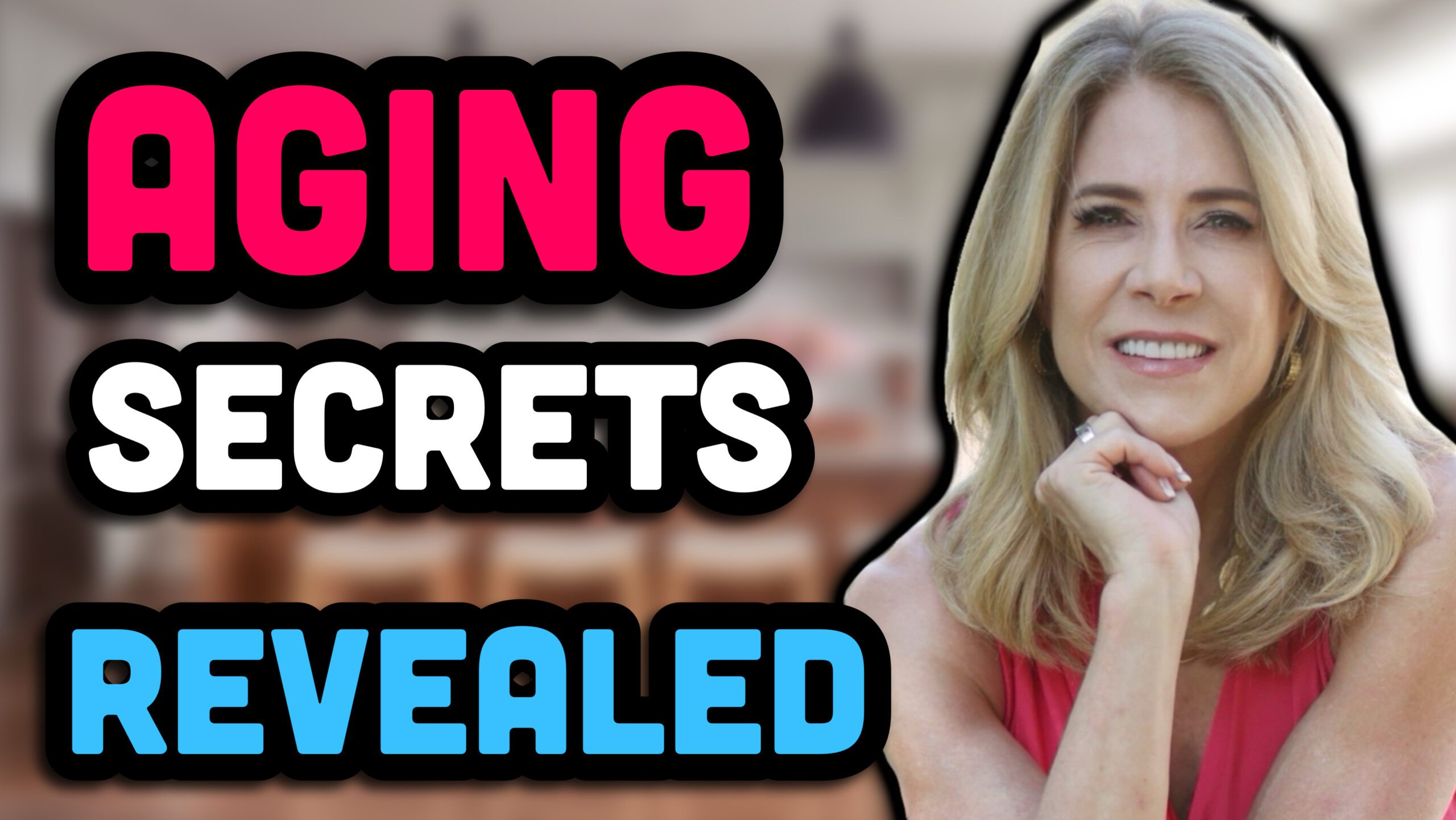
 Subscribe to our show
Subscribe to our show 